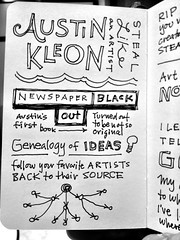Have you felt the change? Are you rediscovering your autumn appetite?
I realized a year or two ago that autumn is my favorite season in the Adirondacks. Along with summer, winter and spring…
Okay, so fall’s definitely in my top four Adirondack seasons. There’s just so much going for it. Like that crisp, chilly air which is so welcome after the humid heat of late summer.
[blackbirdpie id=”249837491983630336″]

And that amazing natural light, so nuanced after the scorching days of August.
[blackbirdpie id=”249842135262707713″]

[blackbirdpie id=”249843196090273792″]

And then there’s yesterday’s sunrise, equally autumnal, but more dramatic than this morning.
[blackbirdpie id=”249463560953012224″]

Not bad, right?
Of course fall is also marked by the shifting palate. For a while I’ve been dreaming of Khoresht-e Bademjan, one of my favorite Persian dishes. Basically, it’s a delicious eggplant stew with a cool name! Although it is typically prepared with beef or chicken, my bride’s vegetarian commitment (more than half of her life and unfortunately no signs or lapsing) challenged the possibilities for this dish. As did the abundance of eggplant and tomatoes I’ve been pulling out of my vegetable garden. Unfortunately, I don’t grow saffron, and our larder was bare. So I improvised a bit.
[blackbirdpie id=”249097651885309952″]
Instagram and Twitter sort of play well together, but the latter likes to clip the former. In this case, you lose. Actually, I lose. Now I need to wander over to my Instagram account and figure out what I said for the other steps. It should have continued: “Blanch 30 seconds, remove skins, stems and cores. Step 3: Add tomatoes and 1/2 bottle of crisp white wine to slow cooker. Step 4: Cook for hours on low heat.” Here’s what it should look like:

[blackbirdpie id=”249554863522996224″]
Okay, back to Instagram’s abbreviated posts again. To continue: “Step 6: Wash eggplant, remove stems and blossom ends, and slice the “long way”. Did you get that, long way? As in, end-to-end rather than slicing the eggplant into thick coin slices.”

[blackbirdpie id=”249583321242279937″]
Step 7: Apply olive oil liberally to all sides of eggplant and arrange on foil-covered sheet. Bake at 400 degrees (F) for 1/2 hour. Step 8: Try to resist eating eggplant while sautéing 1-2 finely chopped onions and 3-4 garlic cloves in olive oil.

[blackbirdpie id=”249584910564741120″]
Step 9: Stir 1/4 to 1/2 teaspoon turmeric into yellow tomato sauce. Step 10: Add baked eggplant spears and sautéed onions/garlic to tomato sauce and slow cook without stirring for 2 hours.

Taste and mix gently, adding salt and pepper to taste. This stew is a totally unique flavor, one that I can summon up from memory. However my Westernized (wine? vegetarian?) variation on this traditional Persian dish is absent two important flavors, safron (subtle) and limes (potent). I used white wine that had begun to turn to vinegar, so some of the zesty acidity of the original was present, but the unique and totally distinct lime (or better yet, dried lime) flavor does improve Khoresht-e Bademjan. Next time!

My bride also prepared a shrimp with sesame and garlic stir-fry, and added another home-grown autumn dish, stuffed peppers.
[blackbirdpie id=”249626197623992322″]

The stuffing was made of minced onions, mushrooms, piñon nuts and quinoa. Pretty tasty if you enjoy woodsy flavors combined with the bite of a baked pepper. Not everyone does, but I’m a fan.

Okay, you say, but what to quaff with autumnal menu?
A tart mug of apple cider would hit the spot.
Or, if you’re sympathetic to the wiles of spirits bachanalian, then you might wish to try E. Guigal’s 2001 Châteauneuf-du-Pape 2001 as we did.
[blackbirdpie id=”249855153174368258″]
It’s getting a bit long in the tooth according to Wine Spectator who awarded it 93 points a decade ago. I thought it complemented the hardy dishes perfectly. Here’s what Wine Spectator had to say about this classic red from the Southern Rhône:
Old-fashioned, this full-bodied traditional wine seduces with its decadent game, saddle-leather, plum and sautéed wild mushroom aromas. No hint of fancy oak, just a mouthful of Châteauneuf character that swirls around to a long, sweet finish. (Wine Spectator)
Intrigued? You might still be able to ferret out a bottle if you’re lucky.
This is a glimpse into my current Adirondack appetite. Crisp air. Thinner, creamier sunlight. And hardy harvest-heavy culinary experiments paired with patina’ed red wines. What’s your autumn appetite?
Like this:
Like Loading...



































 Stiffer breeze than anticipated – better suited to windsurfing than cycling – but after double days of drizzle I’m due for a pedal along the Adirondack Coast.
Stiffer breeze than anticipated – better suited to windsurfing than cycling – but after double days of drizzle I’m due for a pedal along the Adirondack Coast.

